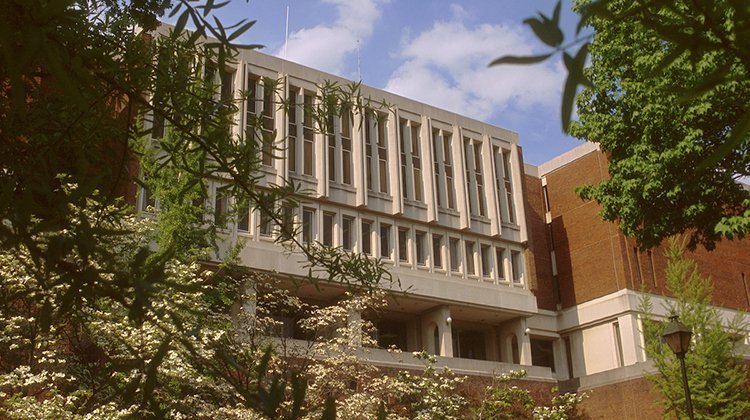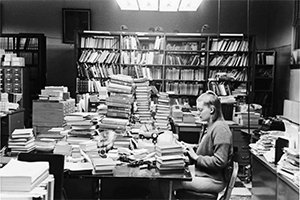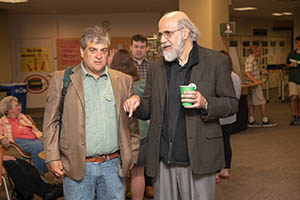
It was 50 years ago – on May 23, 1969 – that Ohio University’s Alden Library was dedicated, ushering in a half century of serving OHIO students, faculty, staff and community members. Photo courtesy of Ohio University Communications and Marketing
Amid all of Ohio University’s academic buildings, there is one that holds perhaps the most memories for the most Bobcats. Some may have only stopped by it a few days a week to print off a paper or return an overdue book. Others spent long, sleepless nights in this building, surrounded by tall cups of coffee and scattered notes.
That building, the “heart” of the academic mission of the University, is Alden Library, which is celebrating 50 years of serving OHIO students, faculty and community members through its growing resources, dedicated staff and evolving technology. Alden Library stands as just the most-recent testament to the broader Ohio University Libraries’ more than 200-year legacy that dates back to 1814.
When Alden Library was dedicated on May 23, 1969, it established an immediate presence as the center of campus. Standing seven stories tall and running roughly the length of a football field, the building was a considerable upgrade from OHIO’s previous Library, housed in Chubb Hall, that opened in 1931.

Pictured is the architect’s rendering of Alden Library. Photo courtesy of the Mahn Center for Archives and Special Collections/Ohio University Libraries
Ohio University’s 15 th president, Vernon R. Alden, was the visionary behind the new Library that bears his name and sought to open a “New Frontier” of excellence and national prominence for the expanding University. At the time, OHIO’s enrollment was increasing, new programs were being established and the Library had outgrown its previous home.
“I said one time that the Library was the most important place within the University,” President Emeritus Alden said in a video produced for his 95 th birthday .“ It serves as a resource for the faculty, for the students and for the townspeople.”
Construction on Alden Library began in 1966 and cost $5.3 million. Originally designed to hold 800,000 volumes, the building was expanded within three years of opening to include the east and west wings on floors five through seven and to accommodate 1.2 million volumes.
Today, the Libraries is home to more than 3 million print and electronic volumes, housed within Alden Library, its Columbus Road annex that opened in 1996 and the Music Dance Library.
TURNING THE PAGE: FROM CHUBB TO ALDEN
Before Alden Library was built, the three-story Edwin Watts Chubb Library served as the gatekeeper of OHIO’s books and reference materials.
An Athens native, Ohio University alumnus and Athens County Juvenile and Probate Court’s presiding judge, Robert Stewart’s experiences with OHIO’s Libraries began long before he became a Bobcat.
Stewart, BBA ’71, grew up in a house on what is now Ohio University’s South Green near where Brown Hall is located.
“It was walking distance to everything,” Stewart said of his childhood home. “I went K-12 and never rode a bus one day, except for field trips and sports. That’s old-school.”
Stewart attended Rufus Putnam School, an Ohio University-operated elementary school that served as a training facility for aspiring teachers.
“It was ahead of its time,” Stewart said of the school that today is known as OHIO’s Putnam Hall and houses the School of Dance. “We had a lot of field trips. We had summer school. And we were kind of guinea pigs in the world of education. A lot of things we tried down there were cutting-edge approaches.”
When her boys were all school-aged, Stewart’s mother, Louise, entered the workforce, securing a position in the reference room of OHIO’s Chubb Library. Stewart vividly recalled his mother’s routine after-school marching orders.
“A lot of days, my instructions were ‘Get your brother, walk up (Jeff Hill) to the Library and wait for me,’” he said.

Anita Ozols works at a typewriter in the cataloging department at Chubb Library shortly before the Library was relocated to the new Alden Library. Photo courtesy of the Mahn Center for Archives and Special Collections/Ohio University Libraries
While the young boys waited, they explored the vast resources of Chubb Library.
“There was a pretty decent sized children’s library as part of the Library at the time,” Stewart said. “If we had stuff from school to read or work on, we could do that. Or we could go pick at the fiction books, or just get an encyclopedia and open it and start reading and see all kinds of stuff.”
When he enrolled at Ohio University, Stewart took on several work-study positions, working in the campus’ cafeterias, in the carpentry shop and at Chubb Library.
“Because I was known at the Library, that was an easy hire for them,” Stewart said. “At that point in time, I already knew my way around.”
As the University prepared to open Alden Library, the Library staff turned to some of its student workers to assist with relocating Chubb Library’s approximately 250,000 volumes to their new home. Stewart was among those students.
Though the historic move required significant organization, that process, Stewart said, was relatively smooth, thanks to the reliable Dewey Decimal System and OHIO’s well-organized card catalog. The books were removed from Chubb Library shelves in an orderly fashion, secured in boxes in a particular sequence, and marked accordingly so that upon arrival to Alden Library they could be stacked and unpacked in the correct order.

A student waits on a tractor outside Chubb Library for another load of books and other materials to be driven to the new Alden Library. Photo courtesy of the Mahn Center for Archives and Special Collections/Ohio University Libraries
It was the physical moving of the books that proved the most challenging.
“There was a lot of grunt labor involved physically in just moving those books around,” Stewart said. “We had two-wheelers to help us, so we would stack maybe four boxes, wheel it out to the truck and put it on. Even though (the new Library) was just around the corner, it was too much to hand-carry box-by-box. We needed trucks.”
Books located on the top floor of Chubb Library were boxed and sent out a window and down a roller to be placed in the trucks.
Once the books arrived at Alden Library, the size of the new facility presented a minor challenge.
“There were so many shelves and so much space there that we probably moved the books two or three times just for aesthetic purposes,” Stewart explained. “We started at the beginning and realized, hell, we got half this floor left and we didn’t have any more books for it! … There was a ton of space when Alden first opened. You could yell out and hear echoes.”
A GATEWAY TO KNOWLEDGE TO ALL, TO PURPOSE FOR SOME
It didn’t take long for Alden Library’s shelves to fill up, and as the years passed and technologies advanced, the Library’s staff kept pace with the changing tides.
In 1971, Alden Library became the first library in the world to generate an electronic library record. In the early 1980s, the Library opened a computer center, and, in 1983, the University’s still-in-use online catalog, known to Bobcats everywhere as “ALICE,” debuted.
Over the years, countless Ohio University students have joined the staff at Alden Library in implementing new and better ways to serve its patrons. University Libraries hires more than 200 students each year, providing them a way to offset the cost of a college education while developing research and communication skills and exploring endless opportunities to learn something new.
Amy Garrett, BSED ’94, was one of these student employees who broadened her skillset during her time at Alden Library and, along the way, found her professional path.
“I was looking for a job and had worked part time for my hometown library, so I had some library experience,” Garrett said about working at Alden Library from 1990-94.
Garrett was assigned to work in OVAL, the Ohio Valley Area Libraries department housed in Alden Library. At OVAL, Garrett and a fellow student were tasked with fulfilling requests from member libraries in Southeastern Ohio for materials available within Alden Library and through the Online Computer Library Center (OCLC).
“We would go to all parts of the Library to retrieve the materials that were requested,” Garrett explained. “Then we would have to send those requests to the member libraries through snail mail and UPS. … I remember a lot of great people there. Everyone was so willing to help. Working in the Library and doing what we did, you weren’t just working within your little cubby or cubicle. You had to work with others on all of the floors, in all different departments.”

Ohio University Libraries employee Steven Cohen stands at a terminal in Alden Library, using the new online catalog system, ALICE, in this 1983 photo. Photo courtesy of the Mahn Center for Archives and Special Collections/Ohio University Libraries
Garrett graduated from OHIO just before the dawn of email and the World Wide Web ushered in a digital age that would forever change the way information is consumed and shared, but she remembered using ALICE in its early years.
“It was very antiquated,” she said of the online catalog. “You always had a flashing cursor when you were searching for something.”
During her first year at Ohio University, Garrett realized she needed to broaden her knowledge of Alden Library, extending the skills she was developing as an employee to those she needed as a student.
“I took a class that basically taught you how to use the Library,” she said.
That class, coupled with the experience she had as an Alden Library student employee, led Garrett down a new career path. She changed her major from interior design to what was then called educational media, a program in OHIO’s Patton College of Education that, among other things, trained students to become school librarians.
After graduating from OHIO, Garrett enrolled at Kent State University where she earned a master’s in library science. Today, she is the head of reference services at the Stow-Munroe Falls Public Library in Northeast Ohio.
“Working in Alden showed me that I really liked library work,” Garrett said.
MOVING FORWARD: INNOVATION AND RENOVATION
At 50 years old, Alden Library is now one of the top 100+ research libraries in North America and has seen more change in the past 15 years than it did in its first 190 years.
Built in a world of print to house physical materials, the building and its staff have adapted to a learning environment dominated by electronic content while also finding ways to better serve students who are visiting Alden Library more frequently.
Today, Alden Library houses a café and study spaces that cater to the broad range of student uses–from deep quiet spaces to collaborative working rooms. Nearly all of the Libraries’ new scholarly content is produced and distributed digitally. And the building’s librarians have launched new avenues to assist students and faculty, using everything from email and text to chat and social media.
Perhaps the biggest change came as a result of feedback directly from students who wanted more access to the building.
In 2005, University Libraries opened the Learning Commons on the second floor of Alden Library, providing 24-hour access five days a week to that floor of the building. A popular destination for late-night studying, that 24/5 access was extended to the building’s fourth floor in the fall of 2017.
“It’s an important change because students are night owls for the most part,” said Bill Reader, a professor in the E.W. Scripps School of Journalism. “As the demographic shifts and students are working overnight on stuff, the Libraries saw a need for students. The Library gets used a lot as a space where students go to study, to work on projects and to collaborate.”

(From left) Bill Reader, a professor in the E.W. Scripps School of Journalism and chair of the University Library Committee, chats with Executive Vice President and Provost Chaden Djalali during Alden Library’s 50th birthday party. Photo by Ben Wirtz Siegel, BSVC ’02
For the past six years, Reader has served on the University Library Committee, chairing the advisory group composed of OHIO faculty, staff and students and witnessing the struggles and triumphs of a library system that serves both campus and community.
Reader noted the work that has been done and will continue to bring a building erected 50 years ago– “when they didn’t foresee things like laptops everywhere and the need for Wi-Fi” —to a place poised for the next 50 years. In addition, he said that University Libraries has not been immune to the financial challenges facing Ohio University and higher education in general.
“The Libraries, while it does have a dean, doesn’t have the ability to generate revenue like the other colleges,” Reader said, adding that belt-tightening has meant cuts in staff and resources. “Amid all those cuts, the Libraries has also done some pretty cool things.”
Reader noted the October 2018 opening of CoLab , a hub for student innovation and entrepreneurship that is housed on Alden Library’s third floor; the expansion and increased digitization of the OHIO Libraries’ special collections ; and the technological role the Libraries plays in many students’ academic journey.
“I think it’s important to recognize that not all students can afford to have their own computers,” Reader said. “The Library provides computer resources that students can use when they’re able to, and it’s because of its location. It’s a relatively convenient location in the center of campus.”
Serving on the University Library Committee has given Reader a broader appreciation for the role Alden Library plays in the mission of Ohio University.
“After I became a member of the committee, I became more informed about the Libraries, what it’s doing and the challenges that it’s facing,” Reader said. “That’s why I have become a pretty strong advocate for the Libraries–not just Alden, but all of the things the Libraries do.”

This panoramic digital print of Ohio University’s Vernon R. Alden Library was taken by OHIO alumnus Thomas R. Schiff, BBA ’70. It is the three millionth item added to the Ohio University Libraries’ collection and was donated by Schiff in honor of Alden Library’s 40th anniversary. Photo courtesy of the Mahn Center for Archives and Special Collections/Ohio University Libraries
For a look back at the history of University Libraries, click here.
We want to hear from you! What are some of your favorite memories of Alden Library? Share your stories in the comments below.

